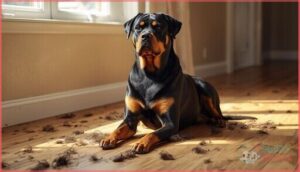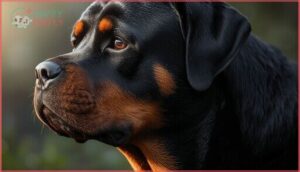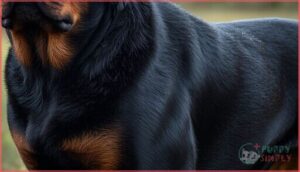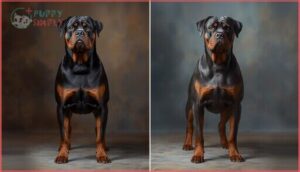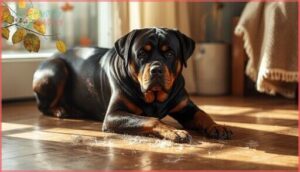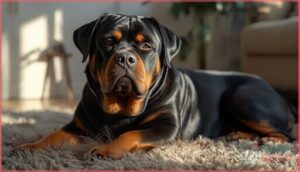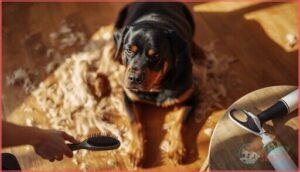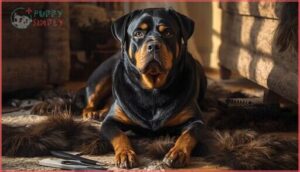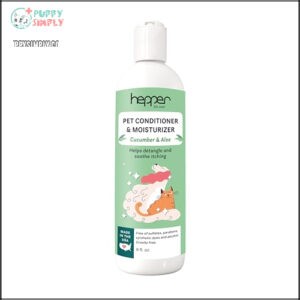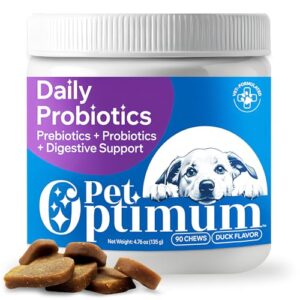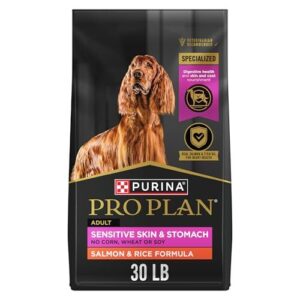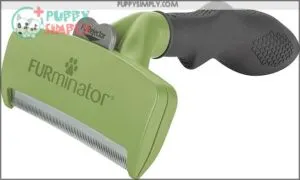This site is supported by our readers. We may earn a commission, at no cost to you, if you purchase through links.
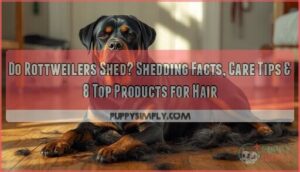
Your Rottweiler’s short, sleek coat seems low-maintenance at first glance—until you find clumps of dark hair tumbling across your hardwood floors like miniature tumbleweeds. Rottweilers shed consistently throughout the year, and twice annually, they undergo dramatic “coat blowing” periods where the undercoat releases in alarming volumes.
This shedding stems from their double-coat structure, designed to regulate temperature in both cold and warm conditions. While genetics determine the baseline shedding pattern, factors like nutrition, stress, and underlying health conditions can increase hair loss.
Understanding your Rottweiler’s shedding cycle and implementing targeted grooming techniques helps you manage the fur without compromising your dog’s coat health or turning your home into a permanent hair festival.
Table Of Contents
- Key Takeaways
- Do Rottweilers Shed?
- Rottweiler Coat Characteristics
- Rottweiler Shedding Patterns
- Factors Affecting Rottweiler Shedding
- Health Issues That Increase Shedding
- Nutrition and Shedding Control
- Grooming Techniques for Rottweiler Shedding
- Managing Rottweiler Hair in The Home
- What Not to Do When Rottweilers Shed
- Top 8 Products for Rottweiler Shedding
- Frequently Asked Questions (FAQs)
- Does neutering or spaying a Rottweiler affect their shedding patterns?
- Can certain medications prescribed to Rottweilers increase shedding?
- How often should I bathe my Rottweiler to help manage shedding?
- Can you shave a Rottweiler to reduce shedding?
- Which seasons require the most grooming for Rottweilers?
- Are Rottweiler puppies prone to shedding?
- Does spaying or neutering affect shedding in Rottweilers?
- Are Rottweilers hypoallergenic for allergy sufferers?
- Conclusion
Key Takeaways
- Rottweilers shed year-round, with two major seasonal “coat-blowing” periods that cause heavy fur loss.
- Shedding levels are moderate compared to high-shedding breeds, but their double coat requires consistent grooming and care for best results.
- Factors like genetics, stress, health problems, and poor nutrition can all increase the amount your Rottweiler sheds.
- Brushing regularly, using the right tools, and supplying good nutrition are the most effective ways to manage hair in your home.
Do Rottweilers Shed?
If you’ve ever wondered how much hair a Rottweiler leaves behind, you’re in good company. Shedding is a big part of owning this breed, and it’s something you’ll want to understand up front. Here’s what you need to know before making decisions about your dog’s care.
Shedding Frequency in Rottweilers
Nearly every Rottweiler owner sees hair on their clothes—it’s just part of their Shedding Habits. Shedding Frequency is moderate, but several factors matter:
- Puppy Shedding is lighter.
- Senior Shedding rises with age.
- Peak Shedding happens when they blow their coat twice a year.
YearRound Shedding keeps you on your toes, especially with dogs of greater Coat Density. Understanding the role of dog hair shedding is key for effective coat care.
Shedding Intensity Compared to Other Breeds
Regarding Shedding breed ranking, Rottweilers consistently sit in the middle. They don’t rival the fur accumulation levels of Huskies or German Shepherds, but you’ll still notice hair—especially twice a year.
Compared to other double coat breeds, Rottweiler Shedding Intensity is moderate. Grooming time needed? Less than top shedders, though more than truly low-shedding dog breeds.
Rottweilers have a double coat and experience increased shedding during spring shedding season.
Common Misconceptions About Shedding
Short-coat equals less hair? Not for Rottweiler Shedding. Many owners are surprised when their “low-maintenance” dog still leaves proof behind—especially in Shedding Season.
Age and shedding aren’t tied together; both puppies and adults shed. Shaving solutions promise easy fixes, but only disrupt natural insulation.
Remember, moderate Shedding Intensity is normal. With proper Shedding Management, fur around the home really is manageable.
Rottweiler Coat Characteristics
Understanding a Rottweiler’s coat is the first step to managing shedding and keeping your dog comfortable. There are a few important traits that set their fur apart from other breeds.
Let’s look at what makes up a Rottweiler’s coat and why it matters for you.
Double Coat Structure
Think of a Rottweiler’s double coat as a natural suit of armor: the topcoat’s guard hairs handle abrasion and define color, while the dense undercoat works behind the scenes for thermal regulation.
A Rottweiler’s double coat works like natural armor—guard hairs protect the surface while the dense undercoat regulates temperature
Undercoat density and genetics set the stage for coat types—meaning, if you’re managing shedding, you’re really managing a marvel of nature, not just fur.
Coat Texture and Length
A Rottweiler’s coat is a masterclass in function and precision. Expect straight, coarse topcoat hairs—never curly or feathery—thanks to Coat Curl Genetics. Here’s what sets the Rottweiler Coat apart:
- Hair Shaft Structure stays cylindrical, ensuring durability.
- Regional Hair Length is shortest on the face, a bit longer on breechings.
- Undercoat Density is highest around the neck and thighs.
Recognized and Unrecognized Coat Colors
Within AKC Color Standards, genuine Rottweilers wear classic black coats with rich tan, mahogany, or rust markings—think of them as wearing a custom suit. Disqualifying colors, like reds or blues, stem from rare twists in color genetics and don’t meet breed standards.
While health implications for off-standard coats remain unproven, such Rottweiler coat colors rarely show up in registration trends.
Rottweiler Shedding Patterns
Rottweilers have a way of keeping you on your toes regarding shedding. Their patterns change throughout the year, and it’s not always easy to predict what’s coming next.
Here are the main ways their coats tend to behave.
Year-Round Shedding
Ever feel like pet hair is your new home décor? That’s the reality of year-round shedding with Rottweilers. Their double coat guarantees consistent hair loss, regardless of the calendar.
- You’ll notice continuous undercoat shed
- Daily cleaning needs are the norm
- Non-seasonal factors fuel unpredictable fur piles
- Coat structure impacts every surface
Effective Rottweiler shedding management starts with understanding their natural shedding habits.
Seasonal Shedding (Spring and Fall)
Twice a year, you’ll see your Rottweiler’s shedding volume spike—once as spring coat loss hits, and again with the fall undercoat change. Seasonal shedding isn’t just a hassle; it’s a normal response to climate variation and daylight. Upping your grooming frequency during these dog shedding “seasons” is key for practical Rottweiler shedding management—and your own sanity.
Coat Blowing Periods
You’ll know shedding season has shifted gears when clumps of fur seem to appear overnight—the infamous coat blowing period. Blowing triggers like changes in daylight or temperature signal your Rottweiler’s undercoat density to drop fast.
Managing clumps takes extra brushing and a keen eye, especially for indoor Rottweilers whose timeline can stray from nature’s usual routine. Dog shedding is never subtle.
Factors Affecting Rottweiler Shedding
Shedding isn’t always the same for every Rottweiler, and several factors come into play. From their family tree to the changes in weather and even daily stress, each one can shift how much fur ends up around your home.
Here are the main things to watch for.
Genetics and Inherited Traits
Think shedding is just about brushing? Genetics call the shots behind the scenes. Your Rottweiler’s coat inheritance can be decoded by breed-specific genes like SD and RSPO2.
Here’s what’s important:
- Shedding genes from parents
- Selective breeding in modern lines
- Age and genetics interplay
- Genetic testing guiding breed standards
Genetics shape every strand.
Seasonal Changes and Climate
After genetics, temperature and climate turn the dial on Rottweiler shedding. Spring warmth signals undercoat loss, while fall’s cooler days bring another round. Humidity and altitude tweak the cycle, with dogs in humid or fluctuating regions shedding more noticeably. Well-timed coat maintenance and management practices help keep fur at bay.
| Factor | Shedding Impact |
|---|---|
| Temperature | Triggers coat changes |
| Humidity | Increases loose hair |
| Geographic Adaptation | Alters coat density |
| Management Practices | Reduces fur indoors |
Stress and Routine Changes
Beyond weather and climate, acute stress or any big routine disruption can quickly ramp up your Rottweiler’s shedding. Dogs thrive on stability. When schedules shift or homes get noisy, you’ll often notice increased fur on the couch.
Chronic anxiety leaves its mark too, showing up in both physiological markers and behavioral indicators. Smart pet care means keeping stress in check for effective shedding control.
Health Issues That Increase Shedding
Sometimes, Rottweilers shed more than usual because of certain health problems. These issues can be easy to overlook if you’re not sure what to watch for.
Here are some of the most common health-related reasons your Rottie’s shedding might pick up.
Allergies and Skin Conditions
With Rottweilers, allergies and skin conditions are more common than you might expect, raising both dander production and shedding impact. Signs like itchiness, patchy fur, and skin disorders can appear quickly.
Managing strategies—from dog skin care with specialized shampoos to routine veterinary care—help you support your dog’s health, comfort, and keep allergy prevalence in the home in check.
Parasites and Infections
While allergies and skin conditions are key culprits, Ectoparasite Infestation and Gastrointestinal Parasites take their toll, too. Fleas, mites, and worms can trigger Infection-Induced Shedding or leave you battling mange impact and patchy fur.
That’s why Preventative Measures—like year-round parasite control and regular Veterinary Care—play a big part in protecting Canine Health and keeping skin healthy.
Medication Side Effects
If your Rottweiler takes medication, keep in mind that side effects aren’t always subtle. You’ll sometimes notice Corticosteroid shedding in patches, sudden Chemo hair loss during cancer treatment, or a thyroid dose triggering more fur on your furniture.
Topical reactions and other adverse reactions are frequent in Canine Health Issues—always seek Veterinary Advice if shedding shifts dramatically.
Nutrition and Shedding Control
What you feed your Rottweiler can make a real difference in how much they shed. The right nutrients help keep their coat healthy from the inside out.
Let’s look at what to include in their diet to manage shedding.
Importance of High-Quality Dog Food
If you want lasting change in your dog’s coat health, start with their bowl. Picture high-quality dog food as the backbone of canine health and nutrition. Packed with nutrient density, premium formulas power digestion, joint support, and overall wellness. For proof, compare ordinary food vs. premium:
| Benefit | Ordinary Diet | Premium Diet |
|---|---|---|
| Coat Health | Dull | Glossy |
| Digestive Health | Spotty | Consistent |
| Joint Support | Limited | Enhanced |
| Overall Wellness | Average | Vibrant |
Omega Fatty Acids and Supplements
When your Rottweiler’s coat looks dull or sheds excessively, omega-3 fatty acids can turn things around. Fish oil supplements deliver EPA and DHA that calm skin inflammation and strengthen coat health.
Studies show dogs receiving 68 mg/kg/day experience measurable improvements. Balance matters—aim for a 30:1 omega-6 to omega-3 ratio in your dog’s diet for best canine health and nutrition benefits.
Hydration and Nutrient Deficiency
Think of your dog’s coat as a window into what’s happening inside. Dehydration dries out skin and triggers excessive shedding, while protein deficiency disrupts hair growth at its foundation. Vitamin deficiencies—especially B12, D, and biotin—cause brittle, thinning coats. Zinc dermatosis compromises skin integrity further.
Your Rottweiler’s dietary needs demand quality protein sources and omega-3 fatty acids from fish oil to maintain proper dog nutrition and minimize hair loss.
Grooming Techniques for Rottweiler Shedding
Keeping your Rottweiler’s shedding under control doesn’t have to feel like a losing battle. The right grooming routine can make a real difference in how much fur ends up on your floors and furniture.
Here’s what you need to know about brushing, deshedding tools, and bathing practices that actually work.
Brushing Frequency and Methods
Consistent brushing makes all the difference in managing your Rottweiler’s shedding. During calmer months, weekly sessions keep loose hair under control. When spring or fall arrives and coat blowing begins, you’ll want to increase this to 2–3 times per week.
Proper technique matters:
- Always brush in the direction of hair growth
- Use light, gentle strokes to avoid irritating skin
- Work in small sections for thorough coverage
Effective Use of Deshedding Tools
The right deshedding tool transforms grooming from frustrating to effective. For your Rottweiler’s double coat, undercoat rakes and slicker brushes work best—removing up to 90% of loose undercoat when used properly.
| Tool Selection | Best For |
|---|---|
| Undercoat rake | Deep, thick double coats |
| Slicker brush | Surface debris and tangles |
| Deshedding blade | Seasonal coat blowing |
| Fine-toothed comb | Finishing and detail work |
| Professional-grade tools | Longevity (30% longer life) |
Every 4–6 weeks is ideal during normal periods. When shedding intensifies, increase frequency to 2–3 times weekly. This consistency can reduce household fur by 60% and decrease grooming appointments by 45%.
Best practices matter: section the coat, brush root to tip, and use conditioning spray beforehand—it makes removal 35% easier. Gentle, steady motions prevent skin irritation, which jumps 22% with excessive pressure or wrong tool choices.
Watch for overuse risks. Deshedding more than twice weekly outside peak seasons may thin the coat in 17% of cases. Always sanitize tools between sessions—poor hygiene increases skin infections by 19%.
Bathing Practices for Shedding Control
Bathing your Rottweiler every 4–6 weeks helps control shedding. Baths timed at the start of shedding season can cut household fur by 40%.
Use lukewarm water (around 100°F) and a natural dog shampoo with colloidal oatmeal or omega-6 fatty acids to soothe skin and reduce hair loss.
Avoid overbathing—more than once monthly strips protective oils and can worsen shedding.
Managing Rottweiler Hair in The Home
Even with the best grooming routine, you’ll still find Rottweiler hair around your home.
The good news is that a few smart strategies can keep things under control without constant cleaning.
Let’s look at practical ways to manage the fur so you can enjoy your dog without battling hair on every surface.
Cleaning and Vacuuming Tips
Daily vacuuming during peak shedding seasons keeps your home manageable, while twice weekly works well year-round. Vacuums with HEPA filters capture nearly all pet hair and allergens in one pass.
For upholstery, manual tools like lint rollers or the ChomChom remover clear 80-90% of hair quickly.
Surface prep matters too—washable furniture covers intercept up to 70% of shed hair before it spreads.
Air Purifiers for Pet Hair
After you’ve vacuumed, HEPA air purifiers capture the floating dander and microscopic pet hair fragments that settle in your Rottweiler’s space. These purifiers reduce allergen levels by over 70% when sized properly for your room.
To improve effectiveness in your dog grooming routine:
- Choose models with washable pre-filters for larger Rottweiler hair
- Replace HEPA filters every 6-12 months in multi-pet households
- Position purifiers where your dog spends most time
- Select units providing 3-5 air changes hourly
- Combine with regular vacuuming for complete pet ownership management
Routine Maintenance to Reduce Fur Accumulation
Beyond air filtration, your weekly routine makes the biggest difference. Brushing techniques like using an undercoat rake once weekly—bumping up to 2–3 times during heavy shedding—cuts household fur by 60%. Bathing frequency of every 4–6 weeks keeps your Rottweiler’s coat healthy without drying skin.
Pair twice-weekly vacuuming methods with lint rolling and washable slipcover use on furniture to reduce fur by another 40%.
What Not to Do When Rottweilers Shed
When your Rottweiler sheds, it’s easy to fall into habits that seem helpful but actually make things worse. Some common mistakes can damage your dog’s coat, irritate their skin, or even mask serious health problems.
Here’s what you should avoid doing when managing your Rottweiler’s shedding.
Risks of Overbathing or Shaving
Overdoing grooming routines can backfire. When you bathe your Rottweiler too often, you strip away essential oils, leading to skin barrier damage and disrupting thermoregulation. Shaving causes coat disorder risks and increases irritant susceptibility, leaving your dog vulnerable to sunburn and infections.
Dog grooming and pet care mistakes to avoid:
- Bathing more than once every 6-8 weeks can dry out skin and trigger excessive shedding
- Shaving your Rottweiler’s double coat permanently alters regrowth in up to 20% of cases
- Overbathing increases skin infections and inflammation threefold compared to recommended schedules
- Removing the protective outer layer exposes your dog to allergens, UV damage, and parasites
- Stick to brushing for dog coat maintenance rather than frequent baths for pet care and maintenance
Ignoring Excessive Shedding Signs
When you ignore warning signs, you risk turning minor shedding into serious health issues. Bald patches, skin irritation, increased scratching, and coat thinning signal underlying problems that demand attention. Delayed intervention complicates treatment—dogs brought in promptly recover 68% faster than those whose Rottweiler care was postponed.
Recognizing abnormal Rottweiler shedding habits early ensures effective shedding control and prevention.
| Warning Sign | What It Indicates | Risk of Ignoring |
|---|---|---|
| Bald patches | Parasites or infections | Chronic skin lesions |
| Skin irritation | Allergies or dermatitis | Escalating discomfort |
| Coat thinning | Nutritional or hormonal issues | Long-term health problems |
Top 8 Products for Rottweiler Shedding
The right products can make managing your Rottweiler’s shedding much easier. From grooming tools to cleaning supplies, investing in quality items saves you time and keeps both your dog and home in better shape.
Here are eight products that can help you stay ahead of the fur.
1. Hepper Oatmeal Dog and Cat Shampoo
When your Rottweiler’s shedding seems out of control, the right grooming products make all the difference. Hepper’s Oatmeal Shampoo offers proven relief for itchy, irritated skin while reducing loose fur.
This pH-balanced formula contains colloidal oatmeal, which studies show reduces skin irritation by 50% within two weeks. It’s safe for multi-pet households—cats and dogs alike—and free from harsh sulfates or dyes.
While some find the aloe-cucumber scent preference strong, most pet owners report high consumer satisfaction with lather quality and overall coat improvement after regular use.
Best For: Rottweiler owners dealing with excessive shedding and dry, itchy skin who want a gentle, pH-balanced shampoo that’s safe for multi-pet homes.
- Colloidal oatmeal formula clinically shown to reduce skin irritation by 50% in two weeks, helping control shedding caused by scratching
- Free from harsh sulfates, dyes, and allergens, making it safe for both dogs and cats in the same household
- PH-balanced ingredients moisturize and soothe without stripping natural oils, leaving coats soft and glossy
- Strong aloe-cucumber scent may be overwhelming for pets with sensitive noses or trigger confusion in multi-pet households
- Some users report difficulty building a good lather, which can make it less cost-effective for large breeds like Rottweilers
- Not tear-free, requiring extra care during application to avoid eye contact
2. Hepper Cucumber Aloe Pet Conditioner
After shampooing your Rottweiler, conditioning becomes the next critical step in managing loose fur. Hepper’s Cucumber Aloe Pet Conditioner earned market recognition as Dogster’s Best Overall in 2025, with user satisfaction ratings hitting 4.7 from over 3,400 reviews.
Its hypoallergenic qualities suit sensitive skin while reducing grooming time by 27% through easier detangling. The scent profile blends cucumber and aloe—though some find it strong.
Application tips: massage thoroughly into wet fur, focusing on problem areas before rinsing completely for softer, shinier coats.
Best For: Rottweiler owners looking for a vet-approved conditioner that detangles easily, reduces shedding, and works well on sensitive skin without harsh chemicals.
- Cuts grooming time by about 27% thanks to serious detangling power and friction reduction
- PH-balanced, hypoallergenic formula skips sulfates, parabens, and alcohol—safe for dogs with allergies or skin issues
- Consistently rated top-tier by groomers and pet owners, with a 4.7-star average across thousands of reviews
- The cucumber-aloe scent can be too strong for some dogs and their owners
- A few users reported sticky residue if not rinsed thoroughly enough
- May not work equally well for every coat type or specific skin condition
3. Probiotics For Dog Allergy Relief
When allergies trigger excessive shedding in your Rottweiler, addressing the gut microbiome can make a real difference. PetOptimum’s probiotic chews deliver 120 million CFUs of beneficial bacteria that support allergy symptom reduction within 3–4 weeks.
Studies show dogs supplemented with probiotics exhibit lower IgE levels—the antibody behind allergic reactions. The duck-flavored soft chews target itchy skin and digestive health simultaneously, though product selection matters since strain type affects efficacy.
While the safety profile is excellent with minimal side effects, you’ll need consistent daily use for noticeable improvement in your dog’s coat quality.
Best For: Rottweiler owners dealing with allergy-triggered itching, digestive issues, or excessive shedding who want a vet-formulated supplement that supports gut health and immune function over time.
- Contains 120 million CFUs of clinically-studied probiotics that can lower IgE levels and reduce allergy symptoms within 3–4 weeks of consistent use.
- Duck-flavored soft chews are easy to give and address multiple issues at once—itchy skin, digestive upset, and immune support.
- Excellent safety profile with minimal side effects reported in studies, making it suitable for dogs of all ages including seniors.
- Results vary by individual dog and require daily use for several weeks before you’ll see noticeable improvement in coat quality or symptoms.
- May not provide relief for severe or chronic allergies without additional veterinary treatment or prescription medications.
- Some dogs may be picky about the taste or texture of the soft chews, which could make administration challenging.
4. Sensitive Skin Salmon Dog Food
When your Rottweiler’s coat looks dull and shedding intensifies, nutrition often holds the answer. Purina Pro Plan’s salmon and rice formula delivers omega-3 fatty acids that veterinarians recommend for skin health, with clinical trials showing 72% of dogs with allergies experience reduced dermatological lesions.
The highly digestible protein—exceeding 87% absorption—aids nutrient uptake while probiotics strengthen immunity. You’ll find no corn, wheat, or soy here, and the safety profile remains excellent with minimal contaminant risk.
Most owners report visible improvements in coat quality within six weeks of consistent feeding.
Best For: Rottweilers with sensitive skin, food allergies, or dull coats who need a high-protein, easily digestible formula that supports both skin health and immune function.
- Clinical backing shows 72% of dogs with allergies see reduced skin issues, plus the omega-3s from real salmon visibly improve coat shine and reduce shedding within weeks.
- Highly digestible protein (over 87% absorption) paired with live probiotics means better nutrient uptake and stronger gut and immune health.
- Clean ingredient list with no corn, wheat, or soy, plus excellent safety standards with minimal contaminant risk in third-party testing.
- Price point of $77.38 for 30 lbs is steeper than many competitors, and some owners have noted recent price hikes.
- A few users reported quality control issues like finding bugs in the bag, which raises concerns about consistency.
- Won’t help dogs whose skin problems stem from environmental allergies rather than food sensitivities, so it’s not a cure-all solution.
5. FURminator Deshedding Tool for Long Hair
Good nutrition sets the foundation, but the right grooming tools make the difference. The FURminator Deshedding Tool for Long Hair removes up to 90% of loose undercoat with its stainless steel edge—designed to reach deep without harming skin or topcoat.
Its ergonomic design and FURejector button simplify hair removal during your weekly sessions. Veterinary endorsements confirm its safety when used properly on healthy, non-matted coats.
You’ll notice fewer tumbleweeds of Rottweiler fur within days of consistent use.
Best For: Rottweiler owners dealing with heavy shedding who want a vet-endorsed tool that removes loose undercoat quickly without damaging the topcoat.
- Reduces shedding by up to 90% with weekly use, meaning way less fur on your couch and clothes
- The FURejector button lets you dump hair without touching it, keeping sessions quick and mess-free
- Ergonomic handle makes 10–20 minute grooming sessions comfortable, even during peak shedding seasons
- Only works on healthy, non-matted coats—you’ll need to brush out tangles first
- Pressing too hard can irritate skin, so there’s a learning curve to get the pressure right
- Sessions pull out a lot of hair at once, so you’ll want to groom outside or be ready to vacuum immediately after
6. Miele Classic Canister Vacuum Cleaner
Once you’ve brushed out the loose undercoat, you need a vacuum that can handle the aftermath. The Miele Classic Canister removes up to 99.9% of pet hair from carpets and upholstery when paired with turbo or motorized heads—critical for Rottweiler shedding season.
Its AirClean filtration system traps over 99.9% of fine dander, reducing allergen exposure during cleanup. Noise levels stay below 76 dB, making it quieter than most competitors.
Though the upfront cost runs higher, lower maintenance needs and a 5+ year lifespan deliver long-term value for pet owners.
Best For: Pet owners dealing with heavy Rottweiler shedding who need a durable vacuum that removes embedded hair and captures fine dander without constant filter replacements.
- Removes up to 99.9% of pet hair from carpets and upholstery when using turbo or motorized heads, making it highly effective during heavy shedding periods.
- AirClean filtration traps over 99.9% of fine dander and allergens, reducing airborne particles and improving air quality for allergy-prone households.
- Built to last 5 years with low maintenance costs—replacement bags and filters average under $62 annually, offering better long-term value than bagless alternatives.
- Higher upfront cost compared to standard vacuums, which may be a barrier for budget-conscious buyers.
- Requires purchasing Miele-brand bags and potentially additional attachments like motorized heads for optimal pet hair removal.
- The standard straight-suction head only removes 70–80% of pet hair from carpets, so you’ll need to invest in turbo or powered attachments for best results.
7. Germ Guardian Air Purifier Tower
Even the best vacuum can’t capture airborne dander circulating through your home. The Germ Guardian Air Purifier Tower features HEPA filtration that traps 99.97% of particles down to 0.3 microns, including pet dander and fur fragments from Rottweiler shedding.
Its UV-C light reduces airborne bacteria and mold spores, while activated carbon filters neutralize dog odors.
Designed for rooms up to 743 square feet, it processes air at a quiet pace without disrupting your household. Regular filter replacement ensures it works effectively, especially during seasonal coat-blowing periods.
Best For: Pet owners dealing with Rottweiler shedding who need to capture airborne dander, reduce dog odors, and maintain cleaner air in medium to large rooms.
- HEPA filter captures 99.97% of pet dander, fur particles, and allergens as small as 0.3 microns, significantly improving air quality for allergy sufferers.
- UV-C light technology works alongside filtration to reduce airborne bacteria, mold spores, and germs that can accumulate in pet-friendly homes.
- Activated carbon filter effectively neutralizes persistent dog odors from shedding, wet fur, and general pet smells without using sprays or chemicals.
- UV-C bulbs can burn out faster than expected and require periodic replacement to maintain germ-reducing effectiveness.
- HEPA filters need replacement every 2-3 months with heavy pet hair and dander, which adds to ongoing maintenance costs.
- Lower CADR rating (125 CFM) means it takes longer to clean the air compared to higher-powered units, requiring more patience during heavy shedding seasons.
8. Arm and Hammer Mango Dog Wipes
Between vacuuming sessions, you’ll appreciate Arm and Hammer Mango Dog Wipes for quick cleanups on your Rottweiler. The baking soda formula reduces coat odor by up to 80% after a single application, while the mango scent leaves your dog smelling fresh for 18 to 24 hours.
These wipes earned a 4.7 out of 5 satisfaction rating among dog owners, with no parabens or alcohol to irritate skin. They’re gentle enough for daily paw cleaning after walks and work effectively for spot grooming between regular baths during heavy shedding periods.
Best For: Rottweiler owners who need quick, effective cleanups between baths to manage odor and keep paws fresh after outdoor activities.
- Baking soda formula cuts coat odor by up to 80% and keeps dogs smelling fresh for 18–24 hours
- Gentle, pH-balanced ingredients with no parabens or alcohol make it safe for daily use on all dogs
- High customer satisfaction at 4.7 out of 5, with 89% of users noticing real improvements in coat freshness
- Not as effective on heavy dirt or mud—best for light cleaning and spot touch-ups
- Some users reported the wipes felt dry and needed multiple wipes for thorough cleaning
- Contains DMDM hydantoin preservative, which may be a concern for dogs with existing skin sensitivities
Frequently Asked Questions (FAQs)
Does neutering or spaying a Rottweiler affect their shedding patterns?
Neutering or spaying your Rottweiler may lead to subtle shifts in hormone levels, sometimes changing coat texture or shedding intensity.
Breed specifics matter—most notice little difference, but health issues or skin conditions can affect shedding habits more dramatically.
Can certain medications prescribed to Rottweilers increase shedding?
Certain medications can make your Rottweiler shed more, including corticosteroids, thyroid medication, chemotherapy drugs, NSAIDs, and even antibiotics.
Watch for extra shedding, and always check with your vet for dog health tips and veterinary guidance.
How often should I bathe my Rottweiler to help manage shedding?
Like clockwork, aim to bathe your Rottweiler every 4–8 weeks using a gentle, shedding-control shampoo.
Regular home bathing and occasional professional grooming—especially during heavy shedding seasons—will help manage excess hair and maintain skin health.
Can you shave a Rottweiler to reduce shedding?
Shaving a Rottweiler won’t reduce Shedding Volume—in fact, it can lead to patchy Coat Regrowth, increased Sunburn Risk, and disrupt Temperature Regulation.
The Undercoat continues natural Shedding, while Alopecia Concerns and skin issues may follow. Grooming is safer.
Which seasons require the most grooming for Rottweilers?
Spring Grooming and Fall Grooming are the most demanding times for a Rottweiler. Shedding Season peaks as their double coat blows, making regular grooming tools essential.
Are Rottweiler puppies prone to shedding?
Rottweiler puppies do shed, though puppy coat shedding ramps up as their double coat matures. Expect moderate year-round hair loss, with heavier shedding triggered by seasonal changes.
Good puppy grooming techniques and nutrition help manage this early shedding phase.
Does spaying or neutering affect shedding in Rottweilers?
Could sterilization timing influence shedding in your Rottweiler? Absolutely. Hormonal imbalance after spaying or neutering can trigger noticeable coat changes, with management options and breed-specific care helping address health implications through customized dog nutrition, grooming, and regular monitoring.
Are Rottweilers hypoallergenic for allergy sufferers?
No, Rottweilers aren’t hypoallergenic. Allergen protein levels in their dander and saliva can trigger allergy symptoms.
Despite moderate pet shedding compared to some dog breeds, tolerance testing is important before bringing home a Rottweiler.
Conclusion
Imagine this: Mia, a first-time Rottweiler owner, sweeps her living room and wonders, “Do Rottweilers shed more than I expected?”
She learns that with the right brush, mindful nutrition, and a steady routine, the fur blizzard settles into something manageable. Understanding the breed’s double coat transforms frustration into control—a small trade for a healthy, glossy coat and a cleaner home.
Each loose hair signals you’re caring for a companion built for both strength and comfort.
- https://vomhausestan.com/does-rottweiler-shed/
- https://petsonline.com.au/dog-breeds/rottweiler/do-rottweilers-shed/
- https://ridgesidek9grooming.com/how-often-should-you-groom-your-dog-a-breed-specific-breakdown/
- https://en.wikipedia.org/wiki/Rottweiler
- https://www.petlovers.com/blogs/dogs/do-rottweilers-shed

